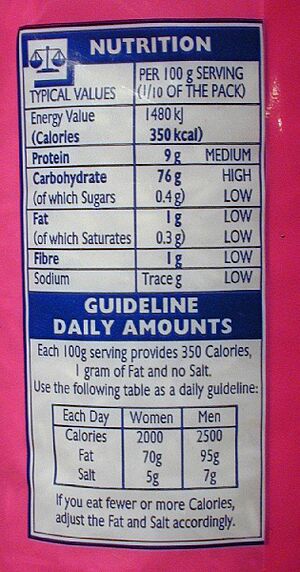Food energy facts for kids
Food energy is the power our bodies get from the food we eat. It's like fuel for our bodies! We get this energy through a process called cellular respiration. This is how our bodies use food and oxygen to create energy. Sometimes, our bodies can even get a little energy without oxygen.
All animals, including humans, need food energy to live and move. This energy helps our bodies work (this is called metabolism). It also powers our muscles.
Most foods are made of carbohydrates, fats, proteins, and water. They also have small amounts of vitamins and minerals. Our bodies get energy mainly from carbohydrates, fats, and proteins. Other things like organic acids and ethanol (alcohol) can also give us energy.
Some parts of food, like water, minerals, and vitamins, don't give us energy. But they are still very important for our health! For example, fiber is a type of carbohydrate that our bodies can't fully digest. But it helps our digestive system work well.
Contents
Measuring Food Energy
Scientists measure energy using units called joules (J). For food, they often use kilojoules (kJ), which are 1,000 joules.
You might also see "calories" on food labels. This is actually a "large calorie" or kilocalorie (kcal or Cal). One kilocalorie is equal to about 4.184 kilojoules. A "small calorie" (cal) is much smaller and is used in science.
In the European Union, food labels show both kilocalories ("kcal") and kilojoules ("kJ"). In the US and Canada, labels usually just say "Calories."
Different foods give us different amounts of energy. Fats and ethanol (alcohol) give the most energy per gram. Proteins and most carbohydrates give less. For example:
- Fats: about 37 kJ (9 kcal) per gram
- Ethanol: about 29 kJ (7 kcal) per gram
- Proteins: about 17 kJ (4 kcal) per gram
- Carbohydrates: about 17 kJ (4 kcal) per gram
When we eat food, our bodies don't use 100% of the energy. About 85% of the energy from food is usually used by a human body.
Nutrition Labels

Many governments make food companies put labels on their products. These labels show how much energy is in the food. This helps people choose foods to control their energy intake.
In the European Union, packaged food labels must show energy in both kilocalories and kilojoules. In the United States, labels usually only show "Calories." In Australia and New Zealand, labels must show kilojoules.
The energy amount on labels is usually for 100 grams of food. It might also show the energy for one serving or for the whole package.
Scientists don't burn food to find its energy content for labels. Instead, they use special tests or look at recipes. They estimate the amounts of protein, carbohydrates, and fat in the food. Then, they use a standard table to figure out the energy value.
Here is a simple table showing how much energy different food parts give:
| Food part | kJ/g | kcal/g |
|---|---|---|
| Fat | 37 | 9 |
| Ethanol (alcohol) | 29 | 7 |
| Proteins | 17 | 4 |
| Carbohydrates | 17 | 4 |
| Organic acids | 13 | 3 |
| Polyols (sugar alcohols, sweeteners) | 10 | 2.4 |
| Fiber | 8 | 2 |
Other nutrients in food, like vitamins and minerals, do not provide energy.
How Much Energy Do We Need?
The amount of food energy a person needs each day changes. It depends on their age, gender, and how active they are.
For example, older people and those who don't move much need less energy. Children and very active people need more.
In the United States, it's suggested that men (31-35 years old) need about 2,600 kcal (10,880 kJ) per day. Women in the same age group need about 2,000 kcal (8,370 kJ) per day. This is for people who do light physical activity.
Australia's health groups don't give one number for everyone. Instead, they suggest different amounts for different age and gender groups. However, Australian food labels often suggest an average daily energy intake of 2,100 kcal (8,790 kJ).
The Food and Agriculture Organization of the United Nations says that the average minimum energy needed per person per day is about 1,800 kcal (7,530 kJ).
How the Body Uses Energy
Our bodies use the energy from food for many things. About 20% of the energy goes to our brain. A lot more energy is used for our organs and tissues to work properly.
When it's cold, our bodies use more energy to stay warm. This is because our metabolism speeds up to make heat.
Our muscles also use energy to help us move and stand up straight. When we exercise, our muscles use a lot of energy.
Our muscles are not 100% efficient at turning food energy into movement. Only about 18% to 26% of the energy from food becomes mechanical energy. This is because some energy is lost as heat during the process.
For example, if you do a lot of physical activity, your body temperature goes up. This also means you are using more energy from food.
The type of food we eat also matters. Some nutrients do more than just give energy. For instance, a nutrient called leucine helps control how our bodies use protein. It can also make us feel less hungry.
See also
 In Spanish: Energía alimentaria para niños
In Spanish: Energía alimentaria para niños

